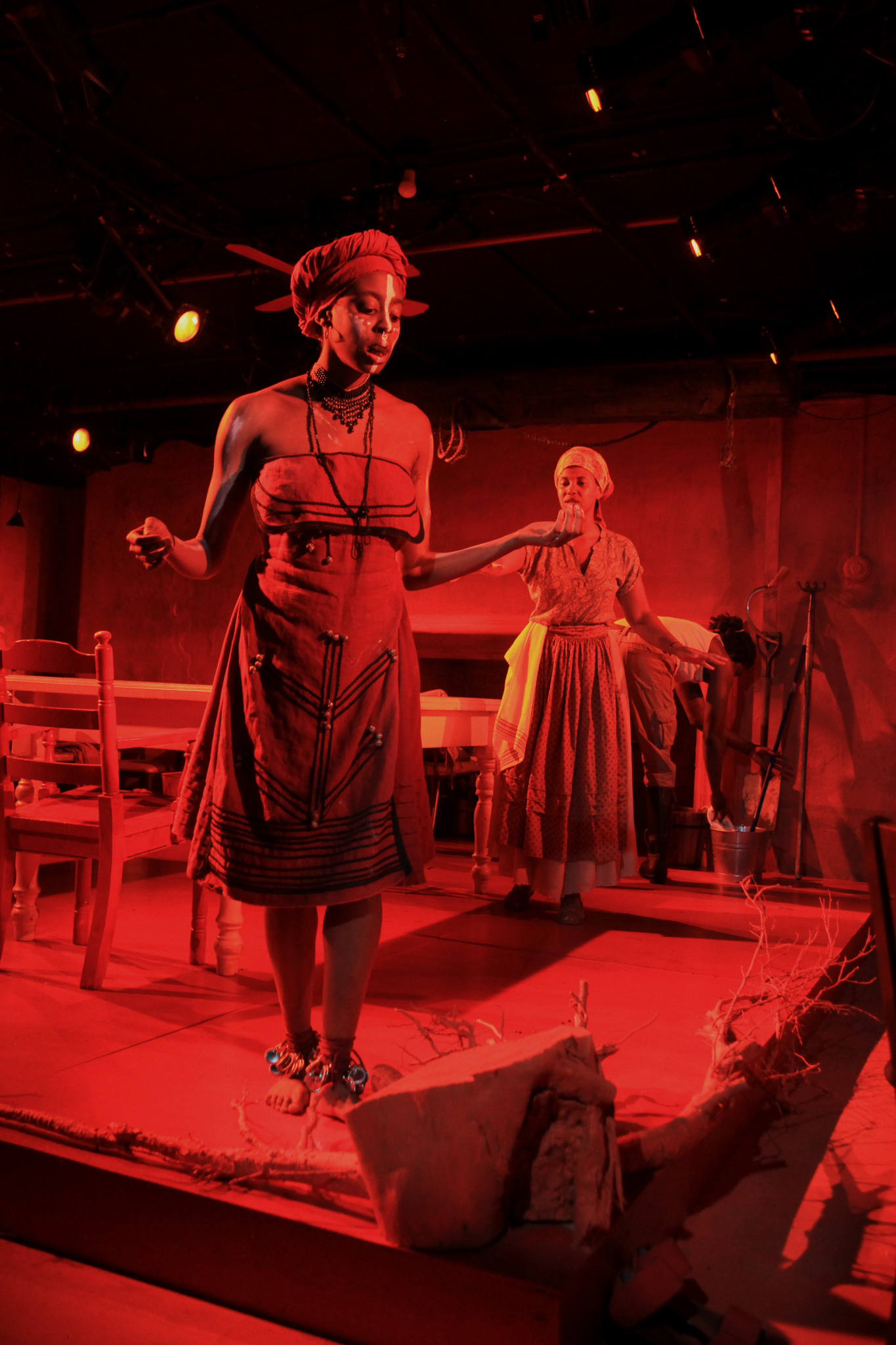Review of the light is…, Yale Cabaret
Movement pieces often present a conundrum. We see bodies in a variety of choreographed routines, we hear music that finds itself embodied in those movements, with costumes, lighting and set contributing to our immersion in the event. How we interpret what we see is where the uncertainty lies.
In the case of the light is…, conceived and directed by third-year Yale School of Drama actor Jake Ryan Lozano, there are also words—words of unusual lyrical polish spoken with a trippy delight by Curtis Williams—that shape our attention more than they provide definite context.
An atmospheric tree of lights stands at one end of the playing space, and the actors/dancers clad in black, with eyes ringed black, move like a group of bodies controlled by a shared impulse. To find the light? To overcome the darkness? Williams, in a boss coat, is a kind of controlling presence, a commentator, a poetic voice above the proceedings. His vocal rhythms and rhyming diction add to the aura.
The five figures—Seta Wainiqolo, Marié Botha, Shadi Ghaheri, Louisa Jacobson, James Udom—move sometimes robotically, sometimes with a kind of desperate yearning or pantomimed fear. It’s fascinating because there’s a distinct feel of a kind of limbo space and we’re wondering what will break them out of the trance. Meanwhile, the trance becomes contagious.
At some point, I have to admit, I stopped trying to piece together a prevailing direction for the show. I started to zone out and think about how great it was to see these six working together. Udom and Wainiqolo worked together in the hypnotic drama The Slow Sound of Snow and in the highly stylized Death of Yadzgerd, which also featured Williams, two shows directed by Ghaheri; Botha and Udom were paired as lovers/antagonists in last year’s Summer Cabaret in a scorching Mies Julie; Jacobson was recently seen as a loose bourgeois in Native Son at the Yale Rep, and a daughter with a mission in Re:Union at the Cab, and Wainiqolo as a stalwart captain in An Enemy of the People, at Yale Rep. The vagaries of the season at the Rep and YSD determines, often, who is available for shows at the Cab, and here six impressive performers (Ghaheri, a third-year director, has appeared in several challenging Cab shows, including Boris Yeltsin, Revolt. She Said. Revolt Again., and Adam Geist) work within arms’ reach, far gone in the throes of a shared crisis condition.
The willingness to explore areas that expand one’s repertoire is what keeps the Cabaret alive, and it’s also a key opportunity for YSDers to take on work that stretches our sense of their capabilities. Lozano, as an actor, has developed a unique command of movement—as seen notably in Titus Andronicus, directed by Ghaheri, and memorably featuring Wainiqolo, as Titus, and Botha, as Tamora. With the light is…, Lozano shows his unique command of poetic language, with touches of Shakespeare, rap, and a musing free association merging to form a mythic invocation of light and our desire for the clarity of paradise.
Moments that stand out to me, in recollection: Udom standing right before my face with a look of deep, permeating sadness, during a sequence when the five, in a ring, seemed to have lost all hope; Wainiqolo leading the five into the ring, all in slow motion, and pantomiming being dragged against their will, his face a mask of fear; the five entering one by one the ring another time with each displaying a comical facial expression and a mechanical tremor as they cross the border; the five reaching up for the source of light, with Jacobsen’s face, in a mute longing, the best illuminated.
And through it all, there’s Williams, in his Cab debut, making us take in the spectacle as an allegory of a world in desperate need of illumination.
the light is…
By Jake Ryan Lozano
Set Design: Alex McNamara; Costume Design: Stephanie Bahniuk; Lighting Design: Dakota Stipp; Projection Design: Erin Sullivan; Stage Manager: Zachary Rosen; Technical Director: Elsa Gibson Braden, Lily Guerin; Producer: Armando Huipe
Ensemble: Marié Botha, Shadi Ghaheri, Louisa Jacobson, James Udom, Seta Wainiqolo, Curtis Williams
Yale Cabaret
January 25-27, 2018
Yale Cabaret goes dark for the next two weekends, then returns February 15th-17th with its annual, not-to-be-missed Drag Show extravaganza.













